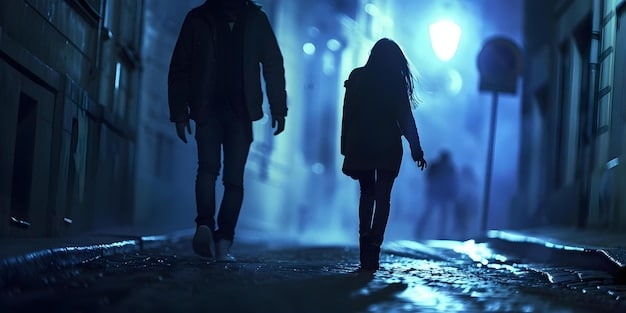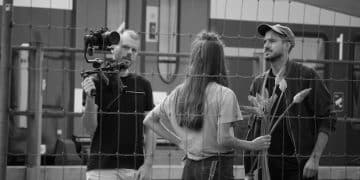The Art of the Micro-Budget: 4 Indie Films That Defy Limits

The Art of the Micro-Budget showcases how indie filmmakers leverage creativity and resourcefulness to produce compelling stories, proving that a limited budget is no barrier to artistic expression and impactful storytelling.
Diving into the world of independent cinema often reveals hidden gems, films crafted with passion and ingenuity despite limited financial resources. The Art of the Micro-Budget: 4 Indie Films That Prove Creativity Trumps Cash demonstrates how constraints can spark innovation, leading to some of the most memorable and impactful stories ever told.
Micro-Budget Filmmaking: Turning Constraints into Strengths
Micro-budget filmmaking is more than just making do with less; it’s an art form in itself. It requires filmmakers to think outside the box, using their creativity and resourcefulness to overcome financial limitations. This often leads to innovative storytelling techniques, unique visual styles, and a raw, authentic energy that can be difficult to replicate in big-budget productions.
The beauty of micro-budget films lies in their ability to connect with audiences on a deeply personal level. Stripped of the distractions of elaborate special effects and well-known actors, these films focus on the core elements of storytelling: compelling characters, relatable themes, and emotional truth.
Embracing Limitations as Opportunities
One of the key aspects of micro-budget filmmaking is the ability to embrace limitations as opportunities. When resources are scarce, filmmakers are forced to be more creative in their approach. This can lead to innovative solutions, such as using unconventional locations, casting unknown actors, and employing DIY special effects.
By embracing these limitations, filmmakers can create a truly unique and original film that stands out from the crowd. They can also develop a strong sense of ownership and pride in their work, knowing that they have overcome significant challenges to bring their vision to life.
- Innovative Storytelling: Micro-budgets often lead to stories that are character-driven and emotionally resonant.
- DIY Aesthetics: Limited resources can create a unique and visually striking aesthetic.
- Community Collaboration: Indie films often rely on the support of local communities, fostering a collaborative spirit.
- Creative Problem-Solving: Filmmakers must find inventive solutions to overcome budget constraints.
Ultimately, micro-budget filmmaking is about proving that you don’t need millions of dollars to tell a great story. With passion, dedication, and a healthy dose of creativity, anyone can make a film that resonates with audiences and leaves a lasting impact.
‘Primer’ (2004): Science on a Shoestring
‘Primer,’ directed by Shane Carruth, is a mind-bending science fiction film that proves you don’t need a Hollywood budget to tackle complex concepts. Made for a mere $7,000, the film tells the story of two engineers who accidentally invent time travel.
What makes ‘Primer’ so impressive is its ability to create a compelling and thought-provoking narrative despite its limited resources. Carruth, who also wrote, directed, produced, and starred in the film, demonstrates a remarkable understanding of cinematic storytelling, using clever editing, sound design, and performances to create a sense of unease and disorientation.
The Power of Ambiguity
One of the reasons why ‘Primer’ has become such a cult classic is its ambiguity. The film doesn’t spoon-feed the audience, instead challenging them to piece together the complex timeline and the characters’ motivations. This ambiguity adds to the film’s intrigue and encourages repeated viewings.
‘Primer’ proves that sometimes, less is more. By focusing on the core elements of the story and leaving room for interpretation, Carruth created a film that is both intellectually stimulating and emotionally engaging.
In conclusion, ‘Primer’ is a testament to the power of independent filmmaking and the ability of filmmakers to create truly innovative and original work with limited resources. Shane Carruth’s dedication and vision shine through, making “Primer” a standout film that redefined what’s possible in low budget filmmaking.
‘El Mariachi’ (1992): From $7,000 to Hollywood Success
‘El Mariachi,’ directed by Robert Rodriguez, is a classic example of a micro-budget film that launched a successful Hollywood career. Made for just $7,000, the film tells the story of a traveling musician who is mistaken for a hitman.
Rodriguez’s resourcefulness and creativity are on full display in ‘El Mariachi.’ He used non-actors, shot in real locations, and borrowed equipment to bring his vision to life. Despite the challenges, he created a film that is both entertaining and visually striking, with a unique blend of action, humor, and Mexican culture.
Innovation on a Budget
One of the most impressive aspects of ‘El Mariachi’ is its use of practical effects. Rodriguez couldn’t afford to hire a special effects team, so he had to come up with creative solutions to simulate gunfights, explosions, and other action sequences. This DIY approach added to the film’s charm and authenticity.
In addition, Rodriguez’s clever use of editing and sound design helped to create a sense of tension and excitement, even with limited resources. He proved that you don’t need expensive equipment to create a captivating cinematic experience.
- Guerilla Filmmaking: Rodriguez’s approach to filmmaking was resourceful and innovative.
- Authentic Storytelling: ‘El Mariachi’ captures the spirit of Mexican culture with humor and heart.
- Career Launchpad: The film catapulted Rodriguez into Hollywood fame.
- Influence on Indie Cinema: ‘El Mariachi’ inspired countless aspiring filmmakers.
‘El Mariachi’ is a shining example of how a micro-budget film can achieve mainstream success. Robert Rodriguez’s talent and determination, combined with a captivating story, made ‘El Mariachi’ a worldwide hit and set the stage for his future success in Hollywood.
‘Following’ (1998): Christopher Nolan’s Noir Debut
Christopher Nolan’s debut film, ‘Following,’ is a neo-noir thriller that showcases his talent for complex storytelling and visual style. Made for a paltry £6,000 (approximately $9,000 at the time), the film tells the story of a struggling writer who becomes obsessed with following strangers.
Nolan’s ingenuity and resourcefulness are evident throughout ‘Following.’ He shot the film in black and white to save money on film stock, used natural lighting, and cast his friends and acquaintances in the lead roles. Despite these limitations, he created a film that is both stylish and suspenseful, with a clever non-linear narrative structure.

Mastering Non-Linear Narrative
‘Following’ is notable for its non-linear narrative, a technique that Nolan would later use to great effect in films like ‘Memento’ and ‘Inception.’ By jumping back and forth in time, Nolan creates a sense of mystery and intrigue, keeping the audience guessing until the very end.
This non-linear structure also allows Nolan to explore the themes of identity, obsession, and the consequences of our actions in a more nuanced and compelling way. ‘Following’ is a testament to Nolan’s talent as a storyteller and his ability to create complex and engaging narratives with limited resources.
In conclusion, ‘Following’ is a remarkable debut film that established Christopher Nolan as one of the most talented and innovative filmmakers of his generation. His ability to create a stylish and suspenseful thriller with a micro-budget is a testament to his creativity and vision.
‘Tangerine’ (2015): Shot Entirely on iPhones
‘Tangerine,’ directed by Sean Baker, is a groundbreaking film that was shot entirely on iPhones. Made for a budget of just $100,000, the film tells the story of two transgender sex workers in Los Angeles on Christmas Eve.
Baker’s decision to shoot ‘Tangerine’ on iPhones was not just a cost-saving measure; it was also a creative choice. The film’s vibrant colors, intimate close-ups, and guerilla filmmaking style capture the energy and authenticity of its subject matter in a way that traditional filmmaking techniques might not have been able to achieve.
Democratizing Filmmaking
‘Tangerine’ is a significant film because it demonstrates that anyone with a smartphone and a good story can make a movie. It democratizes filmmaking, breaking down the barriers to entry and empowering marginalized voices to tell their stories.
The film’s success also proves that audiences are hungry for authentic and diverse stories. By focusing on the lives of two transgender women, Baker created a film that is both entertaining and thought-provoking, challenging viewers to see the world from a different perspective.
- iPhone Cinematography: ‘Tangerine’ showcases the potential of smartphone filmmaking.
- Authentic Representation: The film offers a rare and honest portrayal of transgender sex workers.
- Breaking Boundaries: ‘Tangerine’ challenges traditional filmmaking conventions.
- Critical Acclaim: The film received widespread praise for its originality and impact.
‘Tangerine’ is a game-changer in the world of independent cinema. Sean Baker’s innovative approach to filmmaking, combined with a compelling story and standout performances, made ‘Tangerine’ a critical and commercial success, paving the way for future generations of smartphone filmmakers.
| Key Point | Brief Description |
|---|---|
| 🎬 Micro-Budget Art | Films showing creative storytelling despite limited funds. |
| 💡 ‘Primer’ | Sci-fi thriller crafted for $7,000, demonstrating innovative approaches. |
| 🎸 ‘El Mariachi’ | Shot for $7,000, launched Robert Rodriguez’s Hollywood career. |
| 📱 ‘Tangerine’ | Made for $100,000 and filmed entirely on iPhones, showcasing new possibilities. |
FAQ
▼
A micro-budget film is typically defined as a movie made with a very limited budget, often less than $100,000 but can sometimes reach up to $250,000, relying on resourcefulness to complete filming.
▼
Filmmakers often employ guerilla filmmaking techniques, use non-actors, shoot in available real-world locations, and streamline the crew to minimal viable size to conserve funds.
▼
Yes, it enables greater creative control and artistic experimentation because filmmakers are less influenced by external financial stakeholders and typical studios.
▼
Definitely. ‘El Mariachi’ and ‘Following’ prove that a compelling narrative coupled with ingenuity can garner widespread acclaim and even launch careers in Hollywood.
▼
Technology like smartphones allows filmmakers to shoot high-quality footage affordably, as seen in ‘Tangerine,’ democratizing filmmaking and access to creating content.
Conclusion
These four films exemplify how passion, creativity, and ingenuity can overcome financial constraints in filmmaking. They serve as an inspiration to aspiring filmmakers, demonstrating that with a strong vision and dedication, anyone can create impactful and memorable stories, regardless of budget.





